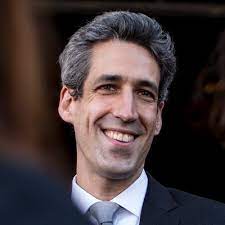Biss encourages Evanstonians to 'find their champion,' get their ideas heard, get involved.
- Nina Kavin

- Nov 12, 2021
- 4 min read
By Katherine McDonnell
Evanston organization Community Alliance for Better Government (CABG) hosted a virtual event with Mayor Daniel Biss this past Wednesday evening focusing on the nuances of Evanston's government and its structure.
Rick Marsh, CABG president and board member Diane Goldring co-hosted the event. Marsh said Biss’ insight could help community members take a more active role in their government.
Founded in 2019, CABG is committed to electing and supporting a responsive and transparent city government, creating actions to increase input among Evanston officials, staff and residents, improving racial diversity, equity and inclusion, and encouraging citizen involvement in civic affairs,
“Some of the goals at CABG are garnering public support and applying pressure to City Council for community wants and needs,” Marsh said.
Rick Marsh, Mayor Daniel Biss, Diane Goldring
Goldring, a previous candidate for City Council, said the ins and outs of Evanston politics and government politics are alienating for many residents, so hearing from Biss can help residents learn how to organize more effectively.
As for Biss, he conceded that Evanston’s political practices are confusing in ways that make progress harder. One of his goals for the event, he said, was to illustrate how specific reforms help simplify the process of turning ideas into tangible outcomes.
“For Evanston City Council, there are two kinds of votes that can occur,” Biss explained. “There are votes on ordinances--and everything else, and much of this 'everything else' tends to be resolutions.”
Biss described ordinances as amendments to the city code –– the collection of all city laws. He outlined how an ordinance can come about, requiring two voting cycles rather than one. He said ordinances must have a vote to be introduced, and then, later, a vote to be passed.
Both of these votes take place within the City Council.
While Biss acknowledged that residents can make proposals, which can occur during public comment at City Council meetings, he said only City Council members or the mayor can currently introduce an ordinance.
Biss emphasized how the number of proposals coming from City Council and staffers alone has created a metaphorical traffic jam in the government “hopper.”
“What we’ve done is created a committee responsible for handling these referrals," he said. "Instead of the referrals being made verbally at a City Council meeting, they’re written and posted online. Instead of magically appearing on a committee’s agenda, there’s now the referrals committee. The job of this committee of three people is to help direct the traffic of ideas coming in.”
Biss said the committee will assess the urgency and ease of proposals to determine if they are ready for a committee or Council vote. Having this committee in place, Biss said, creates greater transparency in the process from the proposal of an idea to its vote.
One of his main goals, Biss said, is to limit any potential “fast-lane” for City Council members or staff to take, essentially skipping the line of proposals or referrals ahead of them to get theirs on the agenda.
Biss said he hopes to encourage citizens to further engage with local government and that raising awareness about how the city’s government functions is an important first step to getting citizens involved in meaningful ways. He said he sees City Council members as highly accessible to residents of Evanston's nine wards, with each ward representative wanting to hear their constituents’ wants and needs.
“Resident groups and interested residents in Evanston are extremely effective at getting the attention of elected officials,” Biss said. “I don’t think it’s very difficult for citizens to make Council aware of changes people want them to make.”
At the end of the event, Biss fielded audience questions regarding the role residents play in referrals and ordinances. Though he reiterated that currently only Council members and city staff are permitted to propose ordinances, Biss said current public opinion could change this.
“There’s interest in creating a voter initiative process in Evanston,” he said, referring to the recently revived call to resurrect the failed 2019 effort that sought to put a measure on the primary ballot in 2020 that would allow Evanston residents to enact local ordinances through the power of voter petition and referendum.
“The way that would have to happen is the City Council would have to pass a resolution creating a referendum, which would go to the people for a vote.”
Everything, Biss said, ultimately comes down to the role voters play in politics. Should interest in a voter initiative process grow, he said, it could become a legitimate proposal for the City Council that could eventually become a reality.
While Biss spent most of the event focusing on ordinances and new developments taking place to simplify the referrals process within Evanston's municipal government, he closed with a reminder that residents have more power in local politics than they might realize.
“Find your champion,” Biss said. “The one Council member who can really stand by you and your ideas.”
Katherine McDonnell is a freshman at Northwestern University studying social policy. She enjoys investigating the ties between journalism and public action.









Comments